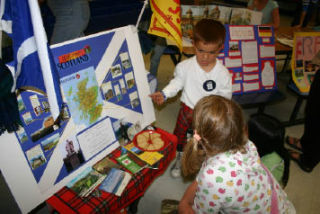Representatives of Iran, Iraq and Israel sat next to each other in the room.
Their countries comprise the tensest, most diplomatically fragile region in the world. But there was no sign of tension on this day.
Christopher Hallock offered pita bread and homemade hummus, and talked of Iraqi soccer, the harsh beauty of the country’s deserts and the vibrant city life in Baghdad.
Alanna Halliday talked of the beauty of Israel’s landscape, its diversity of animal and plant life, and its customs and population.
It was like this throughout the room — representatives of countries from all continents, telling in childlike wonder of the splendors of their homelands. Representatives freely crossed “borders” in friendship. Not a harsh word was spoken, just oohs and ahhs over what each country has to offer.
This was not the United Nations, although you might have left wishing it was. And it wasn’t a meeting of tourism and convention bureaus.
This was Friday Harbor Elementary School’s Cultural Fair, May 28. Third- and fourth-graders took islanders on a world trip with displays about each country they chose to study. They dressed in clothing reflective of their country, shared foods, displayed items and photos they collected, and answered questions with well-researched precision.
Viewing the world through the eyes of a child is refreshing. No politics. Just an afternoon of Nayaleah Tucker-Belt’s love of Portugal’s Lusitano horses, Carlos Felipe-Jimenez’s desire to play soccer in Australia and see that country’s kangaroos, Kai Herko’s samples of Kenyan papayas and his interest in Swahili, and Madrona Jamieson’s Guatemalan corn tortillas.
Jordan Davis was an impressive ambassador for Scotland. Dressed in kilt with sporran, a pouch worn on a chain or belt around the waist, he would have made his ancestor, Thomas Guthrie, proud. Guthrie (1803-73), his great-great-great-grandfather, was the most popular preacher of his day in Scotland and was associated with many forms of philanthropy, among them orphanages. There’s a large statue of him in Edinburgh.
Jordan, a fourth-grader, shared homemade shortbread and shared his knowledge of Edinburgh Castle (1,000 years old, built on an extinct volcano), of St. Andrew’s Castle, of Scottish music (one of his favorites is Battlefield Band, who he’s seen in concert), and, of course, golf. Someday he hopes to play 18 holes in his ancestral homeland, the birthplace of the great sport.
Then, the lively sounds of Mexican folk music filled the air as Ballet Folklorico dancers took center stage. Colorful dresses swished and heels clicked as the dancers kept step with the frenzied music. Above the dancers were signs that seemed to sound the day’s theme: “Empathy,” “Kindness,” “Loyalty,” “Respect,” “Responsibility.”
Teacher Darlene Clark said students learned that they and their peers around the world have unique experiences, but have much in common as well. In some countries, children don’t have access to education like we do in the U.S. But in some countries, children go to school 16 hours a day. In some countries, basic necessities like food and water and medical care are hard to come by; in some countries, people live satisfied lives with less than we have.
But despite differences in cultures, economics and politics, there’s an age when the most important thing to us is the beauty of a horse, or playing soccer, or sharing a corn tortilla and some papaya.
We should look at the world through a child’s eyes more often.
— Contact Richard Walker at 378-5696 or rwalker@sanjuanjournal.com



